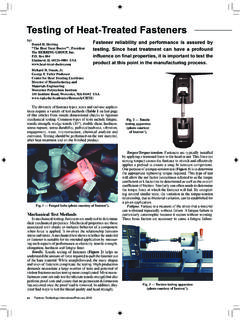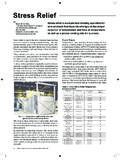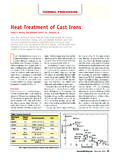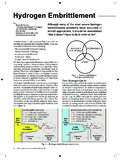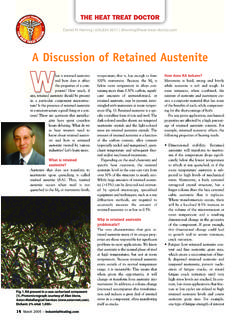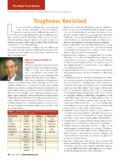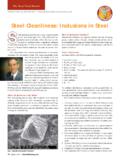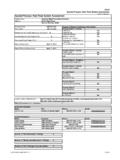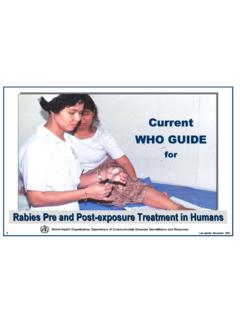Transcription of Heat Treat Dr
1 The Heat Treat Doctor rial H. Daniel H. Herring | 630-834-3017 | .. TH. Temperature Uniformity Survey Tips Part One: Atmosphere Furnaces T. e emperature uniformity surveys (TUS) are a key part of to determine how long it takes a load to reach temperature so as to aany good heat- Treat operation. Speci cations such as better predict soak times. AMS 2750D (Pyrometry) have been referred to by some A. aas the nemesis of many a good heat treater or quality Conducting A Successful TUS and System Accuracy Test engineer. However, if our goal is to ensure we are heat treating to (SAT) in Atmosphere Furnaces the tightest practical tolerances, we must nd ways to streamline Here is some advice gathered from years of doing surveys and from the process for checking uniformity so that we will want to do it a number of industry experts on what you should watch out for more often and with better accuracy.
2 Let's learn more. when conducting a TUS in atmosphere furnaces. Although many Up front, several important decisions of these comments apply to all types of furnaces, atmosphere need to be made: Will the surveys be styles are particularly challenging due to the amount of manual conducted with or without atmosphere, and intervention needed to feed the thermocouple (T/C) wires should they be done with or without a load? through doors, etc. (Fig. 1). For this reason many companies offer Due to safety concerns, most people agree devices that can be placed on a grid or in a basket and run through that surveys in atmosphere furnaces should the furnace. Be aware that there are certain restrictions ( , time be run without an atmosphere present. The at temperature) that apply to these devices. subject of using empty racks or workloads is more contentious.
3 Some feel a survey using Survey Tips baskets or empty racks represents a worst- 1. Make sure the proper classi cation is given to each furnace. case scenario for uniformity. Others feel that an empty furnace Keep in mind that one furnace can be classi ed and used in does not mirror production conditions. more than one way. You cannot use a furnace for a process for Commercial heat treaters often prefer using empty racks because which it has not met temperature uniformity. they cannot predict what a typical load size or con guration will 2. Take the proper number of measurements. Surveys require be. It is important to note that heating pro les should duplicate data points in two-minute intervals for each T/C, including process parameters ( do not slow down ramp to avoid overshoot clear evidence of ramp-up and clear evidence of soak (Fig.))
4 2). with an empty furnace). Auditors will look for this type of detail. 3. Be thorough. Make sure your records show all required details. For captive shops (such as those running automotive components) 4. Make sure any resident SAT probes are not of the same T/C. that heat Treat the same size and type loads every day, it may make type as the control T/C. Also, the SAT thermocouple must be more sense to run the survey with a load as it is more representative located within 3 inches of the control T/C to be valid. Have a of production conditions. In addition, the heat-up data can be used calibration report for both the SAT probes and T/Cs. You now need to periodically perform SAT tests on freezers and quench oils (monthly is acceptable). Frequency of SAT depends on instrumentation type (as does TUS).
5 You are now rewarded with longer times between surveys if you use load T/Cs. 5. Instrumentation calibration is mandatory. Make sure the company meets all calibration requirements for instrumentation. The certi cation must clearly state each is met, along with objective evidence. Each instrument parameter should be calibrated at least three points, and make sure the points calibrated cover the entire operating range. 6. T/C wire traceability is required. Calibration records are needed with clearly stated correction or error factors (these must be properly applied algebraically). Make sure any rolls of wire greater than 1,000 feet are calibrated at both the beginning and end of the purchased roll (use average between Fig. 1. Manual survey method for an integral-quench furnace beginning and end in TUS), and make sure the beginning (Courtesy of Super Systems, Inc.)
6 And end values do not differ by more than 2 F ( C). 20 May 2009 - rial H.. TH. 7. Use Type N for survey T/Cs. In many cases, they are now preferred over type K, from an initial cost and re-use basis. 8. Selection and placement of T/Cs is critical. Attention to every detail demanded by the speci cation is mandatory. 9. Be sure to maximize the contact between the T/Cs and the rack, test slug or part. If the integrity of the contact between these two surfaces is not maintained, you might be logging an extraneous temperature instead of process temperature. 10. Do not weld heat sinks to the survey frame since the contact area makes the heat sink larger than it should be. Heat sinks have been found to make the dif- Fig. 2. Typical survey chart (Courtesy of Super Systems, Inc.). ference with respect to overshooting and also the degree of overshoot.
7 TUS clearly documented. Make sure their time getting equipment ready for 11. Understand the impact of the T/ that during an audit, procedures for production. Cs' thermal mass. Every T/C has an the TUS activity are readily available 19. Don't try to qualify a furnace for effect on the temperature or heating and that the in-house technicians uniformity that is not required. If you characteristics of the product being who perform the surveys know the are only running parts that require a measured. It's important to match the procedures and where to access them. class-5 furnace (AMS 2750D, 25 F. T/C to the job required. If a third party performs the survey, for example), don't try to achieve a 12. Understand the compromise that make sure that the quality department uniformity that is tighter than that.
8 Must be made between T/C life and reviews and signs off on the paperwork 20. Design and fabricate a proper test maneuverability. For example, while prior to ling it. rack. This is especially important 1/8 inch ( mm) diameter T/Cs are 16. Make sure the equipment being when running a survey without a load. common, they are more rigid than say used meets the speci ed accuracy Be sure to place the T/Cs in the same 1/16 inch ( mm) diameter T/Cs. and readability requirements. AMS location each time and run each TUS. 13. Know and record the position of the 2750D, Table 3 de nes a TUS device in as similar a fashion as possible. control T/C in relationship to the as a eld test instrument. Calibration survey T/Cs. Control T/Cs located too accuracy for the device is 1 F ( Final Thoughts close to the walls or too far into the C) or reading in F, whichever Remember that each type of furnace chamber can cause large temperature is greater.
9 Is unique with different methods of variations and different response 17. Have documented procedures on how construction, different heating/cooling times. After surveying, if the control correction factors are used. Make this capabilities and in a different state of T/C was replaced with a different procedure as simple a possible, and repair. For this reason, we need standards type, different gauge-thickness wire, provide examples so that pyrometry that level the playing eld. The intent of different protection tube or located in personnel and auditors can easily eval- AMS 2750D and other speci cations of a different location, the survey must uate survey results and documentation this type is to ensure that one of the most be redone. on corrections used. common equipment variables, namely 14. Clearly de ne the work envelope.
10 18. Make reporting easy. Since surveys temperature, is taken into consideration in Workloads or parts that fall outside take time to perform, make the the overall quality scheme. Part Two will survey dimensions must be considered reporting process simple, consistent provide similar tips for vacuum furnaces having been run in a nonconforming and repeatable so that survey results while Part Three looks at ovens. IH. piece of equipment. can be documented and signed off, 15. Have procedures for performing a and technicians can focus on spending References (available online). 22 May 2009.
